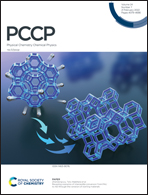The universal relationship between sample dimensions and cooperative phenomena: effects of fractal dimension on the electronic properties of high-TC cuprate observed using electron spin resonance†
Abstract
As demonstrated by the unique electronic properties of nanostructured materials, which are qualitatively different from the bulk properties of the same materials, there should be a general relationship between the dimensions of the sample structures and the physical/chemical properties. However, it is demanding to examine this intriguing problem experimentally, because one cannot prepare a series of samples based on the same material with systematically varying and noninteger dimensions. This problem is solved by considering the fractal dimensions of samples. The electronic structures of a series of powder samples of the high-TC superconductor YBa2Cu3O7−δ with the fractal dimensions (Df) of 2.5–3.0 were investigated using the electron spin resonance (ESR) spectra at 293 K, to determine a general and quantitative relationship between the electronic properties and fractal dimensions of the samples. The observed Df-dependences of ESR parameters, such as g-values and linewidths, were quantitatively consistent with those of the critical temperatures, critical current densities, and lower critical magnetic fields, all of which exhibited anomalies at Df ∼ 2.9. Considering the geometrical features of the fractal models, a hypothesis for explaining the observed Df-dependences of the cooperative phenomena has been proposed, suggesting a universal structural instability at particular fractal dimensions, which affects all the physical and chemical properties of the samples.

- This article is part of the themed collection: 2022 PCCP HOT Articles


 Please wait while we load your content...
Please wait while we load your content...